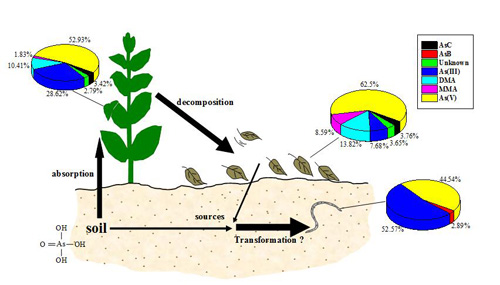Scientists Probe Arsenic Cycle and Bioconversion in Terrestrial Ecosystems
A research group headed by Professor WEI Chaoyang from the Institute of Geographic Sciences and Natural Resources Research, Chinese Academy of Sciences, has considerably enhanced the basic knowledge on arsenic cycle and bioconversion in terrestrial ecosystems.
Arsenic, a ubiquitous but carcinogenic element in the land surface, has been long a popular and scientific topic. An amazing fact on arsenic is its speciation, or in common words, existing forms, which have fantastical varying properties in the environmental media and toxicological effects on biological organisms. Some are in high mobility and extremely toxic, like inorganic arsenite, some are almost non-toxic to organisms, like organic form as arsenobetaine in fish and shrimps. The marine organisms seem to convert arsenic from other organic forms in lower grade into arsenobetaine in higher grade, which has been supposed to be involved in some biological functions like counteraction to high salinity stress to the organisms living in sea waters. While up to date, little is known on arsenic cycle and bioconversion in terrestrial organisms.
By sampling of soils-plants-plant litter-earthworms in the vicinity of a closed arsenic mine in Shimen County, Hunan Province, China, the researchers were successful in making further understanding of arsenic cycle and bioconversion in terrestrial ecosystems. In the paper published recently in Science of the Total Environment, the researchers made detailed comparisons for arsenic variation in forms in various environmental and biological samples.
They found a clue that some lower grade of organic arsenic like methylated forms can be converted to higher grade organic arsenic like arsenobetaine by earthworms in their bodies.
This fact indicate that terrestrial and marine organisms may have common mechanisms in arsenic bioconversion, however, the potential biological functions of arsenobetaine in earthworms remain unknown, like the state in marine organisms.
Another investigation on the wild passerine birds conducted by same group of scientists found abnormal high arsenic levels in the feathers and gastric contents of the birds.
The results have reported in the recently published paper in Chemosphere. They pointed out that arsenic mining activities, although have been closed for 15 years, still produce significant impact on the local terrestrial ecosystem, as evidenced in the birds, the organisms at the top level of the food web in the mining area.
Reference:
Yang Fen, Xie Shaowen, Wei Chaoyang, et al. Arsenic characteristics in the terrestrial environment in the vicinity of the Shimen realgar mine, China. Science of the Total Environment, 2018,626:77-86.
Yang Fen, Xie Shaowen, Liu Jinxin, Wei Chaoyang, et al. Arsenic concentrations and speciation in wild birds from an abandoned realgar mine in China. Chemosphere, 2018,193:777-784.
 |
|
A diagram showing arsenic cycle in a soil-plant- litter-earthworm system (image by YANG Fen) |
Download attachments: